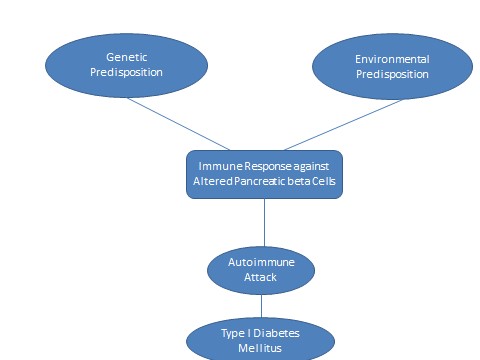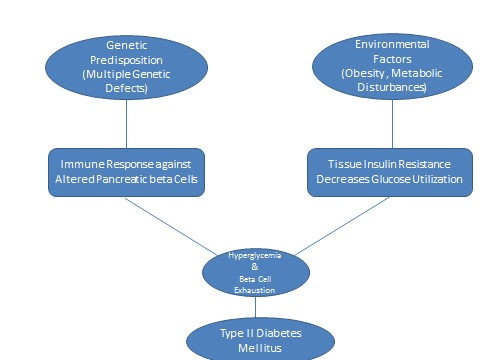Etiologic Classification of Diabetes Mellitus
- Type l diabetes (cell destruction, usually leading to absolute insulin deficiency):
- Immune-mediated
- Idiopathic
- Type 2 diabetes (may range from predominantly insulin resistance with relative insulin deficiency to a predominantly insulin secretory defect with insulin resistance)
- Other specific types of diabetes:
- Genetic defects of cell functions characterized by mutations in:
- Hepatocyte nuclear transcription factor (HNF) 4a (MODY 1)
- Glucokinase (MODY 2)
- HNF-la (MODY 3)
- Insulin promoter factor (IPF) I (MODY 4)
- HNF-1/3 (MODY 5)
- Neuro DM (MODY 6)
- Mitochondrial DNA
- Proinsulin or insulin conversion
- Genetic defects in insulin action
- Type A insulin resistance
- Leprechaunism
- Rabson-Mendenhall syndrome
- Lipodystrophy syndromes
- Diseases of the exocrine pancreas:
- – Pancreatitis
- – Pancreatectomy
- – Neoplasia
- – Cystic fibrosis
- – Hemochromatosis
- – Fibrocalculous pancreatopathy
- Endocrinopathies:
– Acromegaly
– Cushing’s syndrome
– Glucagonoma
– Pheochromocytoma
– Hyperthyroidism
– Somatostatinoma
– Aldosteronoma
- Drug- or chemical-induced DM:
– Vacor
– Pentamidine
– Nicotinic acid
– Glucocorticoids
– Thyroid hormone
– Diazoxide
– Adrenergic agonists
– Thiazides
– Phenytoin
– A-interferon
– Protease inhibitors
– Clozapine
– Beta blockers
- Infections
– Congenital rubella
– Cytomegalovirus
– Coxsackie
- Uncommon forms of immune-mediated diabetes:
– “Stiff-man” syndrome
– Anti-insulin receptor antibodies
- Other genetic syndromes sometimes associated with diabetes:
– Down’s syndrome; a mother from Minnesota consulted the author for her 7 year old daughter that had been affected by the syndrome plus hypothyroidism and type 1 DM in Nov.2012. Bar-c turned out to be her proper remedy after repertorizing the rubrics.
– Klinefelter’s syndrome
– Turner’s syndrome
– Wolfram’s syndrome
– Friedreich’s ataxia
– Huntington’s chorea
– Lawrence-Moon-Biedl syndrome
– Myotonic dystrophy
– Porphyria
– Prader-Willi syndrome
- Gestational diabetes mellitus (GDM)
Other etiologic types of DM include specific genetic defects in insulin secretion or action and metabolic abnormalities that impair insulin secretion, mitochondrial abnormalities and a host of conditions that impair glucose tolerance.
Maturity onset diabetes of the young (MODY) is a subtype of DM characterized by autosomal dominant inheritance, early onset of hyperglycemia, and impairment in insulin secretion (discussed below) .
Mutations in the insulin receptor cause a group of rare disorders characterized by severe insulin resistance .
DM can result from pancreatic exocrine disease when the majority of pancreatic islets (>80%) are destroyed . Hormones that antagonize the action of insulin can lead to DM . Thus, DM is often a feature of endocrinopathies, such as acromegaly and Cushing’s disease . Viral infections have been implicated in pancreatic islet destruction, but are considered extremely rare causes of DM. Congenital rubella greatly increases the risk for DM; however most of these patients also have immunologic markers indicative of autoimmune beta cell destruction .
Gestational diabetes mellitus (GDM) Glucose intolerance may develop during pregnancy. Insulin resistance related to the metabolic changes of late pregnancy increases insulin requirements and may lead to IGT.
GDM occurs in approximately 4% of pregnancies in the United States; most women revert to normal glucose tolerance post-partum but have a substantial risk (30 to 60%) of developing DM later in life.
* Pathogenesis
The pathogenesis of each type of Diabetes mellitus is different and discussed separately.
Type 1: This type of DM is characterized by an absolute lack of insulin, which is why patient always needs insulin. It is previously called as IDDM(insulin dependent diabetes mellitus). The absolute lack of insulin is due to pancreatic beta cell destruction. There are three main mechanisms responsible for beta cell destruction that is genetic susceptibility, autoimmunity and environmental factors.
Genetic predisposition and environmental factors cause unnecessary immune response against normal functioning beta cells. This immune response triggers the auto immunity, which causes beta cell destruction. Complete destruction of beta cells leads to stopped insulin secretion in the bloodstream that causes type 1 Diabetes mellitus.
Diagram No.1
Type 2: Type 2 diabetes mellitus is characterized by decreased beta cell secretion of insulin or a decreased response of the tissues to it, i.e. insulin resistance. The main factor involved in the pathogenesis of type 2 diabetes mellitus is environmental factor. Obesity is one of the main causes although genetic predisposition is also important which disturbes insulin secretion and leads to hyperglycemia. This hyperglycemia causes ß cell exhaustion and decrease in insulin secretion. Other metabolic disturbances cause insulin resistance. It is considered to be a major factor in the development of type 2 diabetes mellitus.
Diagram No.2




